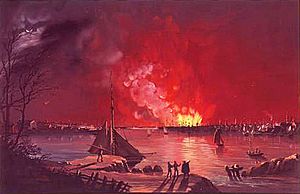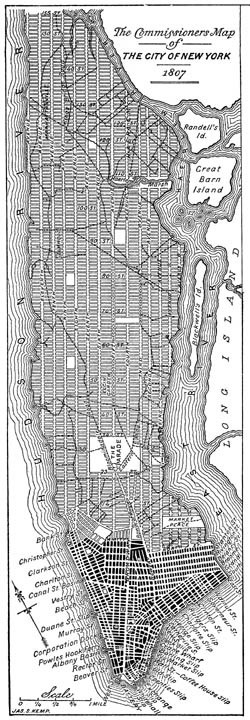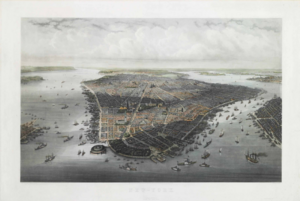History of New York City (1784–1854) facts for kids
The history of New York City (1784–1854) covers a very important time for the city. It began as the capital of the United States, first under the Congress of the Confederation (1785-1788) and then under the new United States Constitution (1789-1790). New York City quickly grew into a major economic hub. This growth was boosted by the opening of the Erie Canal in 1825 and the rise of railroads.
During this period, a political group called Tammany Hall became very powerful. They gained support from many Irish immigrants. By 1854, the first mayor from Tammany Hall, Fernando Wood, was elected. New York City became the nation's most important port and financial center. It also started to compete with Boston as a leading city for culture and arts.
New York City's Early Role
Serving as the Nation's Capital
After the Treaty of Paris was signed in 1783, British troops left New York City. The Congress of the Confederation then moved to Federal Hall on Wall Street in 1785. This was when New York City became the capital of the United States.
The first government, working under the Articles of Confederation and Perpetual Union, was not strong enough for the new country. However, some good things happened in New York. For example, the Northwest Ordinance was passed. This law set up a way for new states to join the country.
A New Yorker named Alexander Hamilton pushed for changes to the Articles. This led to the Annapolis Convention in 1786. States sent representatives to discuss what needed to change. Since not all states were there, they suggested a new meeting. This led to the Constitutional Convention in 1787. There, a completely new governing document was created.
Becoming a Federal City
New York's place in the new country was uncertain. Governor George Clinton was worried about giving too much power to a strong national government. He was against approving the new United States Constitution. Some New York City business people even suggested that New York City should leave the state and join the union on its own.
But Alexander Hamilton and others strongly argued for the state to approve the Constitution. They wrote their ideas in the Federalist Papers, which were published in city newspapers. After much debate, New York finally approved the Constitution in 1788.
In 1789, George Washington became the first President of the United States. He took his oath on the balcony of Federal Hall. The United States Bill of Rights, which protects people's freedoms, was also written in the city. The Supreme Court of the United States met for the first time in New York. However, in 1790, Congress moved the capital to Philadelphia.
Growing Population and Economic Power
New York remained a diverse and international city. In 1810, a French official noted that many people in New York were from other countries. He said they were mostly focused on business. He described New York as a busy place where people were always coming and going.
The official also mentioned that big business deals were made, often with "fictitious capital." This meant people used credit and loans to make deals. This showed how much New Yorkers trusted in future growth. In 1811, the Commissioners' Plan of 1811 was adopted. This plan laid out a grid of streets for all of Manhattan. It was a big vision for the city's future.
New York's population grew very quickly. In 1810, about 96,000 people lived there. By 1860, this number had jumped to over 1 million! This made New York much larger than other major cities like Philadelphia, Baltimore, and Boston.
Historians point to four key actions that helped New York become the top American city:
- The Erie Canal: New York supported the building of the Erie Canal. It opened in 1825. This canal created a water route from New York City, up the Hudson River to Albany, and then west to Buffalo and the Great Lakes. This opened up huge new markets in upstate New York and the Midwest.
- Auction System: New York set up an efficient auction system. Imported goods were sold quickly to the highest bidder. British exporters found they got the best prices in New York. They started sending their goods there instead of Boston or Philadelphia.
- Packet Service: In 1818, New York started the world's first regular packet service to England with the Black Ball Line. By 1830, New York controlled most of the nation's shipping.
- Coastal Trade: New York shippers also developed a large coastal trade. They brought Southern cotton to New York to be sent to textile mills in the Northeast and Europe. They also sent manufactured goods to the South. By 1830, New York brokers earned 40 cents of every dollar mills paid for cotton.
Other cities tried to compete with their own canals and railroads, but they couldn't catch up. Manufacturing was not a main reason for New York's growth at this time. Factories were often built in smaller towns with water power or near coal.
In 1792, a group of merchants made the "Buttonwood Agreement." They started meeting under a buttonwood tree on Wall Street. This was the beginning of the New York Stock Exchange. That same summer, a yellow fever outbreak caused many New Yorkers to flee north to Greenwich Village. In 1797, Aaron Burr took control of Tammany Hall. He used it to help win the state's votes in the 1800 presidential election.
In 1807, Robert Fulton started a steamboat line from New York City to Albany. This made it faster to move goods and people up the river. Lumber and coal were key products brought into New York. Regular steam ferries also helped Brooklyn grow. Brooklyn became a city in 1834.
On September 3, 1821, a strong hurricane hit. It caused a 13-foot storm surge in one hour. This led to widespread flooding south of Canal Street. Few deaths were reported, but it was a powerful storm. This hurricane is thought to be the only one in recorded history to directly hit New York City.
In 1824, a riot happened in Greenwich Village. It was between Irish Protestants and Catholics after a parade. This was an early sign of the Orange Riots that would happen later in the 1870s.
Immigrants were sometimes used by those who opposed ending slavery. Gangs from the Bowery and Five Points often led these groups. On July 7, 1834, a series of riots began. They ended with the destruction of St. Phillip's Negro Church on Center Street. The riots caused fear in the Five Points area.
In 1831, as the city kept growing, the University of the City of New York was founded. It is now New York University and is located at Washington Square Park in Greenwich Village. The first of several cholera outbreaks started in 1832. By 1835, after the epidemic passed, Manhattan began its first big building boom.

Late on December 16, 1835, the Great Fire of New York broke out. The temperature was below zero, and strong winds were blowing. Firefighters, some from as far away as Philadelphia, struggled to fight the wind-driven fire. Their hoses and pumps froze. The fire destroyed 50 acres (200,000 square meters) in the Financial District. Some goods were moved to churches thought to be fireproof, but several of these burned too. The fire was finally stopped by blowing up buildings in its path.
Many merchants who lost their stores thought insurance would cover them. However, the huge losses, and the destruction of many insurance company offices, caused the insurance firms to go bankrupt. Much of the damage was not covered.
The fires of this time and the growing need for water for industries led to the building of the Croton Aqueduct water system. This happened between 1837 and 1842. The aqueduct brought fresh water from the Croton Dam in northern Westchester County. It crossed the High Bridge to a reservoir between 79th and 86th Streets and Sixth and Seventh Avenues. From there, water flowed into the Distributing Reservoir, also known as the Croton Reservoir. The aqueduct opened on October 14, 1842, with a big celebration. Important people like President John Tyler and former presidents John Quincy Adams and Martin van Buren were there.
The city's fast growth was slowed down by the Panic of 1837, a financial crisis. But the city recovered. By the mid-1800s, it had become the financial and trade capital of the Western Hemisphere.
The Great New York City Fire of 1845 destroyed 345 wooden buildings in the Financial District.
The Hudson River Railroad opened on October 3, 1851. This railroad, which later became part of the New York Central, extended the first railroad in the state, the Mohawk and Hudson Railroad, south to New York City.
The Rise of the Immigrant City

New York City and its nearby areas grew quickly for several reasons. The natural harbor around Manhattan, Brooklyn, and the New Jersey ports of Newark and Elizabeth offered huge space for trading ships. It also protected them from storms. New York was the world's busiest port until 1985.
Other cities like Boston, Baltimore, and Philadelphia also had good harbors. But New York had an advantage: the Hudson River and the Erie Canal. These formed the only water route through the Appalachian Mountains.
New York City was known for being open to many different cultures. This encouraged many immigrant groups to settle there. Starting in the late 1840s, the city saw a big increase in Irish immigrants due to the Great Irish Famine. There was also a rise in German immigrants because of the Revolutions of 1848.
Many Irish people arrived poor and unfamiliar with their new world. Unfair landlords offered them crowded, dirty apartments in old middle-class houses. These slums became known for high rates of disease. German immigrants were often skilled workers and craftspeople. They settled in a new neighborhood called "Kleindeutschland" (Little Germany). They opened many shops and worked as artisans. Many Irish immigrants helped build the city's subways and skyscrapers.
The city's rapid growth created large middle, upper-middle, and upper classes. But the need for workers also led to a huge wave of immigration. This created the famous "melting pot" where many people found success and achieved the American dream. In the mid-to-late 1800s, there was a big difference between rich areas like lower Broadway, Washington Square, Gramercy Park, and Lafayette Street, and very poor areas like Five Points (which later included the Lower East Side).
Tammany Hall's power grew as it sought the votes of Irish immigrants. This led to the election of Fernando Wood as the first Tammany mayor in 1854. The region also began to consolidate. The three-year-old City of Williamsburgh joined Brooklyn in 1855. This made Brooklyn America's third largest city.
See also
 In Spanish: Historia de Nueva York (1784-1854) para niños
In Spanish: Historia de Nueva York (1784-1854) para niños
- American urban history
- Timeline of New York City, 19th century
Chronology
| Preceded by History of New York City (1665–1783) |
History of New York City (1784–1854) |
Succeeded by History of New York City (1855–1897) |



